Summer of 2013 was the first time we had fertile eggs from Yasha (female) and Casanova (male). Both are Cyclura lewisi hybrids.
So we had to learn how to put together an incubator that would accommodate cyclura eggs. Best suggestion came from Ty Park and we followed his instruction.
Buy chicken egg still air incubator. Set the temperature to 86F. Temperature can fluctuate between 84-88F.
Use two plastic tupperware containers and vermiculite. But also can use perlite or a mix of both. Some pet stores might carry already made egg incubation medium like Hatchright.
It’s easier to get two smaller container and separate the eggs as they would fit better in that incubator.
Fill the containers half way with vermiculite or other medium moistened by weight with water to 50/50 ratio and place eggs half buried on top.
Lay eggs down gently inside the containers. If you see any red spot, put that to be top. Mark the top of the eggs with sharpie or any pen, pencil and do not turn eggs over. Turning the eggs will kill the embryos.
Punch 4 to 6 small ventilation holes in the lid of the container. Cover the eggs. Place the containers inside the incubator.
Put a cup filled with water inside the incubator to keep the humidity. If you see moisture residue on the walls inside the egg containers or the incubator, please air it out for an hour or two.
If the medium gets too dry you can add a little water to it, but be careful so water doesn’t touch the eggs or they don’t drown.
Humidity should be about 80-85%.
Do not add water to medium past 90 days of incubation.
Cyclura eggs average incubation period is 80-100 days at 86F and can be 60-80 (less typical) day with higher temperatures like 88-89F.
Good luck!
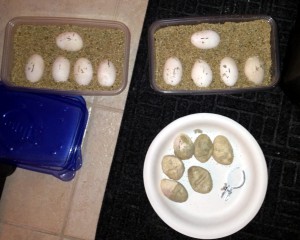
Cyclura eggs: left container will be incubated on the left and right container will be incubated on the right (for future references)
You can see the fertile eggs in the boxes already filled with vermiculite medium.
Infertile eggs are soft and dented on the paper plate.
Yasha laid 16 eggs in 2013: 10 fertile and 6 infertile.
Update: 1 week into incubation one fertile egg went bad and was taken out. 9 remain good.
Update: 4 weeks into incubation one egg developed a green slimy small spot. Got separated but still remains inside the incubator. 8 eggs remain good.
Update: 6 weeks into incubation. 8 eggs are still good and 1 with the spot and looks questionable.
The questionable egg collapsed even further and was smelling bad. So we discarded it after 48 days.
Update: 9 weeks into incubation (63 days). We had purchased Hot Box 24″ incubator and moved the eggs from the chicken incubator.
We had preheated the incubator for couple of days and monitored the temperature since it was the first time we were using it. It kept the temperatures very steady, so we finally transferred the containers with eggs into it. I had added some dishes with water to keep the humidity.
Update: 10 weeks (70 days). Within a week the Hot Box incubator build up a lot of condensation inside. I had been wiping off excess humidity daily, but it has been building right back up. It maybe due to too many water containers inside. All water dishes had been removed, except 1 glass of water. Next day there was no excess condensation any longer.
Update: 10.5 weeks (day 73) I had noticed that couple of eggs developed dents. At this point it can be due to lower humidity (eggs getting dryer inside the Hot Box incubator since I had removed extra water dishes) or eggs are getting ready to hatch.
In the photo above you can see the eggs with dents. Container with eggs remain covered with lids and the lids were taken off just for the photo purpose.
Update: 12 weeks (83 days) All eggs except 1 had developed dents. It could be due to getting ready to hatch or maybe due to low humidity. Some eggs are very dented and some are slightly dented. Caved in eggs appear to have harder surface, but still softer bottom. Today I put down damp paper towels on the top of the dented eggs under the lids to keep the the humidity level higher around the eggs. You can see the example of using damp paper towel here. I had also put additional glasses of water inside the incubator. Right now it has 3 glasses of water.
Since HotBox incubator has constantly moving air flow versus still air incubator, the level of humidity may need to be adjusted accordingly.
Update: 12 weeks (84 days) Our first hatchling poked his head out this morning. It was the egg in the right container, top left one. You can see that the egg was very caved in. Other eggs remain the same.
Update: 12 weeks, (85 days) Another very dented egg is hatching that is in the left container, the egg on the right that is by itself.
Update: 12 weeks, (86 days) One more egg is hatching this morning. This time it’s right container, left row, bottom egg.
Check out the update on the first 3 babies in this post: Cyclura Babies Hatching: Alpha, Beta, Gamma
Update: 12.5 weeks, (88 days) Two babies hatched today. Left container, left row: first egg from the top followed by the second egg from the top.
Update: 13 weeks, (90 days) One more egg hatched, right container, the egg by itself.
Update: 13 weeks, (92 days). Two last eggs hatched. Left container, first row, bottom egg. Followed by the second egg from the bottom.
All done! Success!

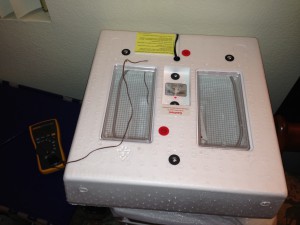
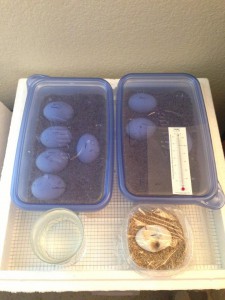
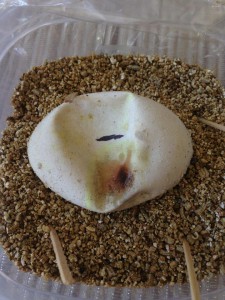
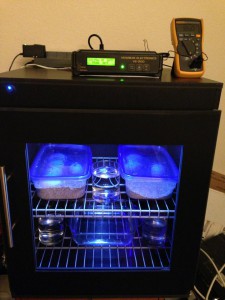
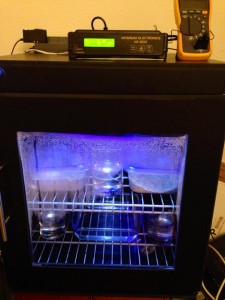
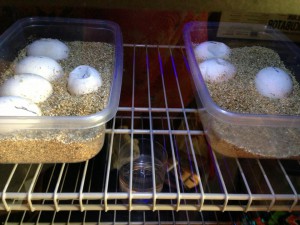
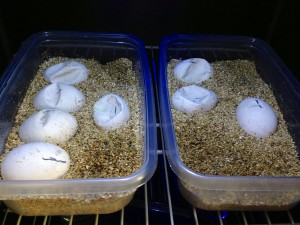
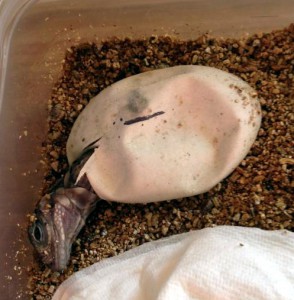



Pingback: How to increase humidity for dry fertile cyclura eggs | Reptile Function
Pingback: Cyclura babies hatching 2013: Alpha, Beta, Gamma | Reptile Function